Bandaging
Bandaging . Learning Objectives. Discuss indications for bandaging of wounds and describe the general structure of bandages Describe common types of bandages, slings, splints, and casts used for small and large animals and provide indications for their use. Learning Objectives.
Share Presentation
Embed Code
Link
Download Presentation
- wound surface moist
- wound dressings
- burn patients
- excessive pressure
- minimal disruption
- telfa pads gauze sponges

alisa + Follow
Download Presentation
Bandaging
An Image/Link below is provided (as is) to download presentation Download Policy: Content on the Website is provided to you AS IS for your information and personal use and may not be sold / licensed / shared on other websites without getting consent from its author. Content is provided to you AS IS for your information and personal use only. Download presentation by click this link. While downloading, if for some reason you are not able to download a presentation, the publisher may have deleted the file from their server. During download, if you can't get a presentation, the file might be deleted by the publisher.
Presentation Transcript
- Bandaging
- Learning Objectives • Discuss indications for bandaging of wounds and describe the general structure of bandages • Describe common types of bandages, slings, splints, and casts used for small and large animals and provide indications for their use
- Learning Objectives • Describe procedures for monitoring of animals with casts, bandages, splints, or slings • Discuss considerations for bandaging of abrasions, lacerations, puncture wounds, and degloving injuries • Describe classifications of burns and discuss management of burn patients
- Bandaging Purpose Protection • To prevent simple fractures from becoming more complicated • Protection from licking, scratching, biting and any other forms of self mutilation • From infection or further contamination • Holding wound dressings and cold compresses in place • Immobilizes the wound and promotes healing
- Bandaging Purpose • Support • To improve mobility • To reduce pain and swelling • Extra support for internal fixation of fractures
- Bandaging Purpose - Compression bandages are a useful first aid measure to help arrest hemorrhage. - Post operatively, bandaging is useful to prevent excess swelling; therefore reducing and preventing edema Compression
- Bandaging Purpose Immobilization • Of a fractured limb to prevent further trauma to damaged soft tissue • Of limb to aid speedy recovery of open wounds if near a joint, where excessive movement is undesirable • Of limb, if fracture repair is complicated and/or near the joint requiring complete rest • If internal fracture repair is not sufficient, and extra support in the form of a bandage is needed • Following manipulative procedures, after dislocated hips having been reduced
- Bandaging Purpose Strapping/Securing • To hold IV catheter in place • To keep limb extended for fluid lines and other such procedures • When necessary, to secure tail bandage to base of tail • To tape pinnae together above dogs head, for ear or head bandage
- Bandages – Wound Healing Promotion of Wound Healing by: • Protecting the wound from additional trauma and contamination • Preventing wound dessication (drying up) • Preventing hematoma and seroma formation • Immobilizing the wound to prevent cellular and capillary disruption
- Bandages – Wound Healing • Minimize post-op edema around incision • Absorbs wound exudate and lifts away foreign material & loose tissue as bandage is removed • Promotes an acid environment • Keeping wound warm
- Important Points to Remember • The bandage must serve the purpose for which it was intended • The bandage must be applied firmly, but not so tightly that circulation is impaired • It must be as comfortable as possible for the patient. • It must look professional – take pride in its appearance
- Bandage Layers Primary (contact layer) Is the first layer and it is in direct contact with the skin or wound Telfa Pads Gauze Sponges Open wounds should have a sterile primary layer
- Primary Layer: Functions Debridement Deliver medication Transmit exudate to 2nd layer Seal wound
- Primary Layer – Adherent • An adherent primary layer promotes debridement in the inflammatory stage • Uses a wide mesh material (sterile gauze), allowing tissue to become incorporated into the bandage. This tissue is then removed with the bandage change • Not highly recommended due to unselective debridement and damage during the proliferative (repair) stage of wound healing • Painful to remove • Must be changed daily • Bacterial proliferation and strike-through = disadvantages with wet/dry primary layer
- Types of Adherent Primary Layers • Dry-to-dry • Used when loose, necrotic tissue is evident. • Absorbs exudate, necrotic tissue, and foreign material. • Debris adheres to dry, sterile gauze and is removed with bandage change • Wet-to-dry • Used for wounds with dried or semi-dry exudates • Gauze is soaked in saline or chlorhexadine and applied wet • Loosens material from the wound by rehydration • As it dries, exudate is pulled into the material and away from the wound
- Adherent Primary Layers (cont’d) • Wet-to-wet • Used on wounds with large amounts of exudates and transudates • Material covering the wound is kept moist, sometimes by injection of fluid into the bandage • Absorbs fluid easily • Can be used to heat wound, increasing capillary action and drainage of wound • Removed wet (less pain) • Disadvantage: little wound debridement because of decreased adhesion to necrotic tissue
- Primary -Nonadherent • Moist wound care is the most important management principle • A nonadherent bandage is usually a fine mesh, nonstick material. This layer promotes moisture retention and epithelialization with minimal disruption of granulation bed. • Moist wound care enhances natural debridement within the wound by drawing the exudate form the wound and allowing the wound to bathe in this cytokine-rich material • Involves the uses of nonadherent primary bandage layers that act to keep the wound surface moist • Moist wound care results in less inflammation and less wound disruption • Either occlusive or semiocclusive
- Primary -Nonadherent • Semiocclusive • Allows air and moisture to move through the dressing • Keeps wound moist yet draws exudate and debris form the wound • Indicated for moderate to copious exudate • Must be changed frequently (Every 1 – 3 days, depending on exudate production)
- Primary – NonadherentSemiocclusive • Hydrogel • Hydrocolloid • Hydrophilic • Polyurethane film • Hydrophilic colloids (Refer to p. 1237 of CTVT text)
- Primary - Nonadherent Occlusive • Impermeable to moisture • Allows some air transfer • Indicated for minimal exudate • Promotes epithelialization • Changed infrequently (every 4-7 days) • Can be used as a protective layer for new epithelium preventing desiccation and abrasion of the fragile tissue. • Some products adhere to skin (hydrophilic or non-hydrophilic)
- Bandage Layers Secondary Covers the primary layer and supports the wound Purpose is to be able to absorb and store fluids from the wound Materials that can be used for this layer are cast padding or cotton roll. This layer should not be applied with excessive pressure but snug enough to keep the primary layer in
- Bandage Layers Tertiary layer This is the holding and protective layer that holds the bandage in place Usually consists of two layers Vet Wrap Elastakon Cling gauze
- Tertiary Layer • Should be nonocclusive to allow air transfer • Strike-through = outer layer becomes wet, allowing moisture (and bacteria) to wick through the rest of the bandage MUST CHANGE IMMEDIATELY! • Occlusive = contraindicated (traps excessive moisture leading to tissue maceration)
- Technician Note • The middle two toes of a bandaged limb should always be exposed to allow for assessment of color, warmth, and swelling
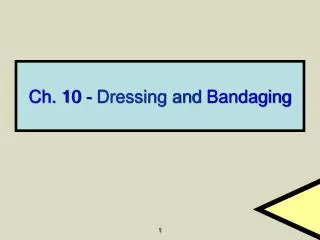
Ch. 10 - Dressing and Bandaging
Ch. 10 - Dressing and Bandaging. 10.1 Dressings. Requirements : Sterile , meaning that any microorganisms and spores on the dressing have been killed Aseptic , meaning that it is free of bacteria
1.35k views • 15 slides
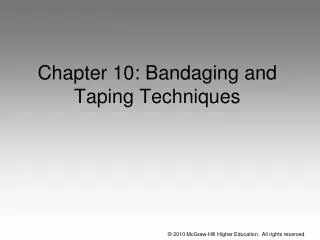
Chapter 10: Bandaging and Taping Techniques
Chapter 10: Bandaging and Taping Techniques. Routinely used various reasons Provide compression to minimize swelling Injury prevention Provide additional support to an injured structure Application requires skill
1.91k views • 35 slides
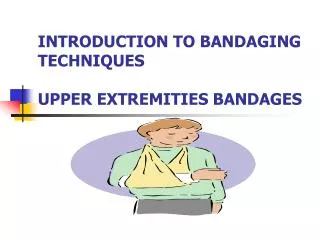
INTRODUCTION TO BANDAGING TECHNIQUES UPPER EXTREMITIES BANDAGES
INTRODUCTION TO BANDAGING TECHNIQUES UPPER EXTREMITIES BANDAGES. DRESSINGS . PURPOSE OF DRESSINGS Control bleeding Prevent infection and contamination Absorb blood and fluid drainage Protect the wound from further injury. DRESSINGS. TYPES OF DRESSINGS GAUZE PADS
1.58k views • 10 slides
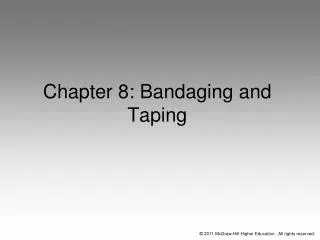
Chapter 8: Bandaging and Taping
Chapter 8: Bandaging and Taping. Routinely used by athletic trainers Used to minimize swelling, provide support to injured areas and prevent injury While techniques are not difficult to master, trained professional should apply Requires solid background in anatomy and biomechanics
1.32k views • 69 slides
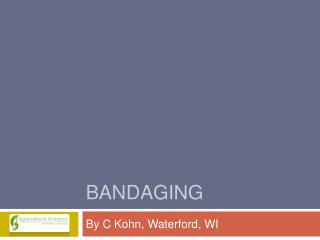
Bandaging
Bandaging. By C Kohn, Waterford, WI. Not all wounds heal equally. Not all wounds heal equally. More-serious wounds take longer to heal. Individual factors also influence how quickly your body is able to recover from a wound, including the following:
650 views • 17 slides
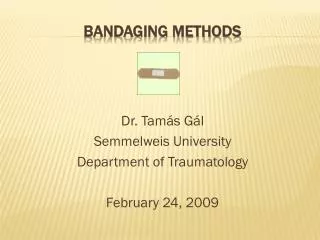
Bandaging methods
Dr. T amás G ál Semmelweis University Department of Traumatology February 24 , 2009. Bandaging methods. For the purpose of holding dressings of all kinds in place , to obtain compression , to give support , or correct deformities , and finally , to immobilize splints . .
909 views • 31 slides
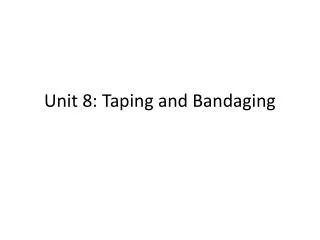
Unit 8: Taping and Bandaging
Unit 8: Taping and Bandaging. Equipment Terms. Protective Equipment: Specialized sports equipment that is used to protect athletes from injury.
410 views • 23 slides
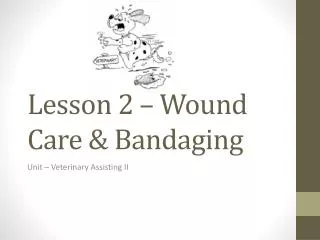
Lesson 2 – Wound Care & Bandaging
Lesson 2 – Wound Care & Bandaging. Unit – Veterinary Assisting II. Client….
250 views • 11 slides

Bandaging
Bandaging. Originally Created By Craig Kohn Modified By Jamie Propson . Not all wounds heal equally. Not all wounds heal equally. Not all wounds heal equally. More-serious wounds take longer to heal.
1.49k views • 25 slides

Wound Healing/ Bandaging
Wound Healing/ Bandaging . VTDRG pp. 403-411 CTVT pp. 1235-1247. Learning Objectives. Describe the process of wound healing List and describe the factors that affect wound healing Discuss initial management of wounds in small animals. Learning Objectives.
553 views • 32 slides

BANDAGING
BANDAGING. Bandaging. There are dozens of different bandaging methods designed for specific areas of the body or specific purposes. The two areas most commonly bandaged are the abdomen and the legs. ABDOMINAL BANDAGE. Commonly referred to as the “bellyband”
1.59k views • 10 slides
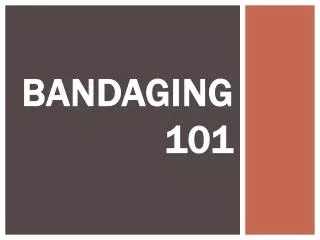
Bandaging 101
Bandaging 101. Bandaging. There are dozens of different bandaging methods designed for specific areas of the body or specific purposes . The two areas most commonly bandaged are the abdomen and the legs. Abdominal Bandage. The abdominal bandage is commonly called the bellyband .
546 views • 10 slides

Chapter 8: Bandaging and Taping
Chapter 8: Bandaging and Taping. Bandaging. Will contribute to recovery of injuries When applied incorrectly may cause discomfort, wound contamination, hamper healing Must be firmly applied while still allowing circulation. Materials.
936 views • 57 slides
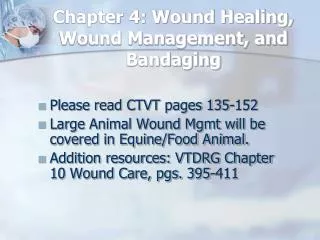
Chapter 4: Wound Healing, Wound Management, and Bandaging
Chapter 4: Wound Healing, Wound Management, and Bandaging. Please read CTVT pages 135-152 Large Animal Wound Mgmt will be covered in Equine/Food Animal. Addition resources: VTDRG Chapter 10 Wound Care, pgs. 395-411. Wound Abrasion Granuloma Debridement Avulsion Necrotic Laceration
1.36k views • 56 slides

First Aid Dressing and Bandaging
First Aid Dressing and Bandaging. Module 2. First Aid Dressing and Bandaging. Objective Use as a cover To immobilize To support To secure dressing Serve as a pad Arrest bleeding. First Aid Dressing and Bandaging. Guidelines in dressing and bandaging
10.32k views • 27 slides

Chapter 8: Bandaging and Taping
Chapter 8: Bandaging and Taping. What are the nine rules for tape application? If the part to be taped is a joint, place it in the position in which it is to be stabilized. Overlap the tape at least half the width of the tape below. Avoid continuous taping.
1.02k views • 24 slides

Bandaging and Taping Techniques
Bandaging and Taping Techniques. Chapter 11. Chapter Objectives. Explain the need for and demonstrate the application of elastic bandages. Demonstrate site preparation for taping. Know the various types of tape that can be used
791 views • 12 slides

Bandaging and Taping
Bandaging and Taping. Routinely used by athletic trainers Used to minimize swelling, provide support to injured areas and prevent injury While techniques are not difficult to master, trained professional should apply Requires solid background in anatomy and biomechanics
717 views • 22 slides

INTRODUCTION TO BANDAGING TECHNIQUES UPPER EXTREMITIES BANDAGES
INTRODUCTION TO BANDAGING TECHNIQUES UPPER EXTREMITIES BANDAGES. DRESSINGS. PURPOSE OF DRESSINGS Control bleeding Prevent infection and contamination Absorb blood and fluid drainage Protect the wound from further injury. DRESSINGS. TYPES OF DRESSINGS GAUZE PADS
584 views • 10 slides

Chapter 9 Dressings, Bandaging, and Immobilization Techniques
Chapter 9 Dressings, Bandaging, and Immobilization Techniques. EMR 9- 1. Introduction. The EMR must be familiar with different types of dressings, bandages, and immobilization techniques to properly care for patients with wounds and fractures
374 views • 23 slides

Chapter 8: Bandaging and Taping
Chapter 8: Bandaging and Taping. Alireza Ashraf, M.D. Professor of Physical Medicine & Rehabilitation Shiraz Medical school. Bandaging. Will contribute to recovery of injuries When applied incorrectly may cause discomfort, wound contamination, hamper healing
637 views • 56 slides

Compression Bandaging Market Size and Forecast to 2026
The report discovers the marketu2019s total sale that is generated by a particular firm over a time period.
122 views • 7 slides
























